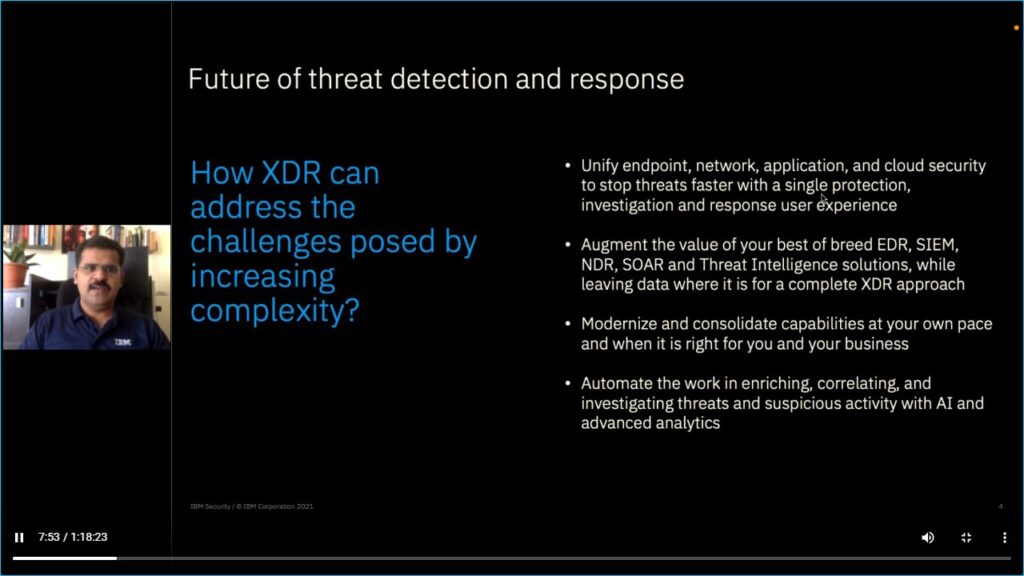Threat Detection and Response needed improvements. To mark the new year, IBM and SMEVenture are kickstarting the “Unravelling Security” series to encourage thought-provoking discussions, display engaging demos, and share fresh insights on key cybersecurity topics relevant today.
Taking Threat Detection and Response to the next level with XDR | Unravelling Security
The first session in the series “Taking Threat Detection and Response to the Next Level with XDR” was organized on 27th Jan 2022. Mr. Pradeep Vasudevan, Threat Management Leader, IBM Security, led the session.
To overcome webinar fatigue, the session was conducted in a unique role-play business interview format to give it some fresh energy. The innovative format saw Pradeep playing the role of a trusted advisor, answering questions of a fictitious CISO while presenting before the audience on how enterprises can launch or accelerate their XDR journey.

Key cybersecurity challenges driving XDR adoption
As IT environments become increasingly dispersed with the proliferation of devices, users and technologies, CISOs cite several reasons that hamper a robust cyber resiliency framework. Key reasons include:
- Too many disconnected tools & integration complexity leads to increase in costs without adding value
- Too many false positives causing real threats to be missed
- Complex and disjointed workflows meaning there’s a significant amount of manual work required to investigate threats across system – slows down MTTR
- New and inexperienced security teams struggle to keep up with the complex tools and often lack the skills to build and maintain their own detection and response strategy
“Given the dramatic change in the complexity of environment and existence of blind spots due to decreased visibility, the risk of missing threats is at an all-time high,” says Pradeep.
XDR can help organizations modernize threat detection and response
To strengthen cyber resiliency, CISOs must take threat management to the next level with a unified and connected approach that provides deeper visibility, automation, and contextual insights across endpoint, network, cloud, and applications.
Extended Detection and Response or XDR offers that.
Pradeep says, “An XDR solution can unite multiple siloed security tools and reduce the complexity that impedes fast detection and response. It can provide more advanced analytics and automated workflows giving teams plenty of time to investigate and hunt for threats.”
What is IBM’s POV on XDR?
IBM has announced a new suite of XDR offerings under the QRadar brand. IBM QRadar XDR helps security analysts break down the silos between the proliferation of point products in the industry – providing comprehensive visibility across security tools and data sources, whether in the cloud or on-premises. The QRadar XDR equips the security teams with the key insights needed to act quickly and comprehensively. It rests on 4 key pillars:
Connected: QRadar comes with industry’s largest Open XDR ecosystem that can integrate your EDR, SIEM, NDR, SOAR and Threat Intelligence, while leaving data where it is.
Unified: Simple XDR workflows, co-designed with experts, help speed up alert triage, threat hunting, investigation and response.
Intelligent: Automate the work of enriching, correlating, and investigating threats with purpose-built AI and pre-built playbooks, including automated root cause analysis and MITRE ATT&CK mapping.
Open: Built on IBM Cloud Pak for Security for deployment on premises as well as cloud, and ready for use by security service providers
Pradeep concludes, “IBM is a proponent of open technologies and high-end open ecosystems within organizations. The enterprises availing our XDR approach need not scrape their existing investments that they have undertaken for securing their systems.”
Where can IBM QRadar customers start their XDR journey?
IBM is offering a no-charge QRadar Value Assessment (QVA), a comprehensive health assessment of QRadar deployments that can help enterprises make the best utilization of the existing investment on QRadar platform.
Learn More about QRadar XDR
By,
Prasad P. Patkar
